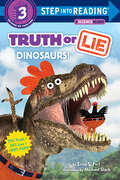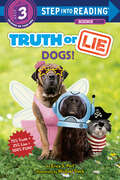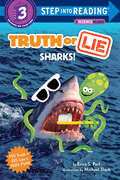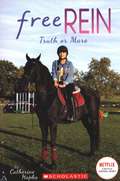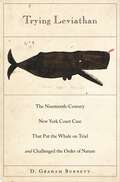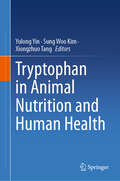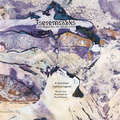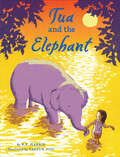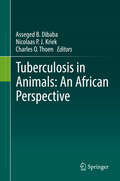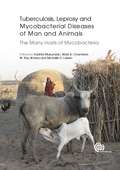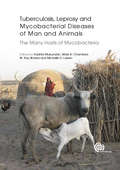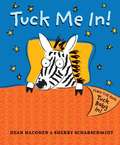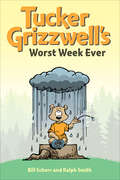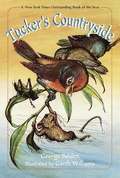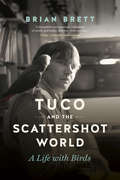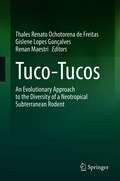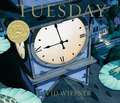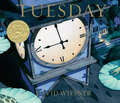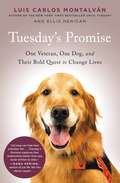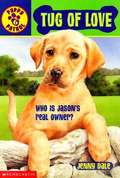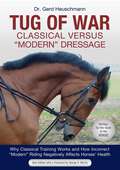- Table View
- List View
Truth or Lie: Dinosaurs! (Step into Reading)
by Erica S. PerlDinosaur fanatics will love hunting down the TRUTH about their favorite prehistoric reptiles in this innovative new Science Reader series.Tyrannosaurus rex's closest living relative is the alligator, right? That's a LIE! The TRUTH is, the massive carnivore was actually more closely related to chickens!! Though this engaging early reader is 100% fun, 25% of it is FALSE! In a unique question-and-answer format, proficient readers are quizzed about dinosaurs to see if they can separate facts from "lies." The book's mascot--the Truth Sleuth--guides readers through this funny and fact-packed Step 3 Reader, which features photos and illustrations of dinosaurs and fossils, with funny, kid-appealing art by Michael Slack.Step 3 Readers feature engaging characters in easy-to-follow plots about popular topics, for children who are ready to read on their own.
Truth or Lie: Dogs! (Step into Reading)
by Erica S. PerlYoung dog lovers will enjoy sniffing out the TRUTH about their favorite animals in this innovative Step 3 nonfiction reader.Dogs don't sniff each other's butts as often as we think, right? That's a LIE! The TRUTH is, dogs almost always greet each this way! It gives them lots of information about other dogs. Though this engaging early reader is 100% fun, 25% of it is FALSE! In a unique Q&A format, proficient readers are quizzed about dogs to see if they can separate facts from "lies." The book's mascot--the Truth Sleuth--guides readers through this funny and fact-packed book, which features photos and illustrations of a wide variety of canines.Step 3 Readers feature easy-to-follow plots about popular topics, for children who are ready to read on their own.
Truth or Lie: Sharks! (Step into Reading)
by Erica S. PerlShark lovers will enjoy hunting down the TRUTH about their favorite ocean predators in this innovative new Science Reader series.Baby sharks are toothless at first, right? That's a LIE! The TRUTH is, sharks are born with a mouthful of teeth to protect themselves and hunt right away. Though this engaging early reader is 100% fun, 25% of it is FALSE! In a unique question-and-answer format, proficient readers are quizzed about their favorite ocean predators to see if they can separate facts from "lies." The book's mascot--the Truth Sleuth--guides readers through this funny and fact-packed Step 3 Reader, filled with photos of sharks in action, as well as kid-appealing art and humor.Step 3 Readers feature engaging characters in easy-to-follow plots about popular topics, for children who are ready to read on their own.
Truth or Mare (Free Rein)
by Catherine HapkaThe riders of Bright Fields Stables are playing a game of Truth or Dare – or rather, Truth or Mare, since the horses are involved, too! All of the riders' fun dares end up on Becky's vlog, which she hopes will make it big. Meanwhile, there's a ghost dog that might be running around Pin's castle – anda treasure to be found.
Trying Leviathan: The Nineteenth-Century New York Court Case That Put the Whale on Trial and Challenged the Order of Nature
by D. Graham BurnettIn Moby-Dick, Ishmael declares, "Be it known that, waiving all argument, I take the good old fashioned ground that a whale is a fish, and call upon holy Jonah to back me." Few readers today know just how much argument Ishmael is waiving aside. In fact, Melville's antihero here takes sides in one of the great controversies of the early nineteenth century--one that ultimately had to be resolved in the courts of New York City. In Trying Leviathan, D. Graham Burnett recovers the strange story of Maurice v. Judd, an 1818 trial that pitted the new sciences of taxonomy against the then-popular--and biblically sanctioned--view that the whale was a fish. The immediate dispute was mundane: whether whale oil was fish oil and therefore subject to state inspection. But the trial fueled a sensational public debate in which nothing less than the order of nature--and how we know it--was at stake. Burnett vividly recreates the trial, during which a parade of experts--pea-coated whalemen, pompous philosophers, Jacobin lawyers--took the witness stand, brandishing books, drawings, and anatomical reports, and telling tall tales from whaling voyages. Falling in the middle of the century between Linnaeus and Darwin, the trial dramatized a revolutionary period that saw radical transformations in the understanding of the natural world. Out went comfortable biblical categories, and in came new sorting methods based on the minutiae of interior anatomy--and louche details about the sexual behaviors of God's creatures. When leviathan breached in New York in 1818, this strange beast churned both the natural and social orders--and not everyone would survive.
Tryptophan in Animal Nutrition and Human Health
by Yulong Yin Sung Woo Kim Xiongzhuo TangThis book integrates the research progress of Tryptophan (Trp) and its metabolites in animal nutrition and human health. It recapitulates the effects of Trp nutrition on the regulation of various physiological functions in farmed animals as well as the clinical connections between Trp metabolism and human diseases. Furthermore, this book includes detailed information about the manufacturing process of industrial Trp production and methodologies to study Trp metabolism. This book not only brings numerous benefits to academic communities worldwide but also provides practical values for industrial professionals/companies. Both of these two aspects will expand our understanding of how amino acid metabolism contributes to the maintenance of host health.
Tseremsaaks, and Nagunaks, the Whale-Chief: A Tsimshian mythical legend retold and illustrated by Roy Freeman
by Roy FreemanA group of brothers go fishing and inadvertently let their anchor down onto the undersea house of Nagunaks, the chief of the whales. What happens then? A mythical legend from the native peoples of the Canadian Pacific Coast with a lesson from the whale that inspires our relation to all animals and nature. The illustrations inspire fantasy, curiosity, and discovery, inviting the story to come alive with their shapes, forms, and colors. A book to explore and enjoy, for all ages.
Tsukiji: The Fish Market at the Center of the World (California Studies in Food and Culture #11)
by Theodore C. BestorA vivid and fascinating ethnography of the world's largest marketplace for fresh and frozen seafood, Tokyo's gigantic Tsukiji market, where $6 billion worth of fish trades hands each year.
Tua and the Elephant
by R.P. HarrisTen-year-old Tua—Thai for "peanut"—has everything she needs at home in Chiang Mai, Thailand, except for one thing she's always wanted: a sister. In the market one day, Tua makes an accidental acquaintance—one with wise, loving eyes, remarkable strength, and a very curious trunk. And when Tua meets Pohn-Pohn, it's clear this elephant needs her help. Together, the unusual team sets off on a remarkable journey to escape from Pohn-Pohn's vile captors. From the bustling night market to the hallowed halls of a Buddhist temple and finally, to the sanctuary of an elephant refuge, this clever girl and her beloved companion find that right under their noses is exactly what each has been searching for: a friend.
Tuberculosis in Animals: An African Perspective
by Charles O. Thoen Asseged B. Dibaba Nicolaas P. J. KriekThis book recounts the biology of M. bovis, followed by the status of bovine Tuberculosis (bTB) in African countries, primarily based on zoonotic and epidemiological field reports. Since the accumulation of data is valueless unless it led to practicable control measures, emphasis is put on locally adapted protocols for future control of the disease. In order to systematically evaluate the knowledge base of bTB, Epidemiologic Problem Oriented Approach (EPOA) methodology was used. The methodology is composed of two triads: i) the problem identification/characterization triad, which is mainly descriptive in nature, and ii) the problem management/solution/mitigation triad, which is mainly geared toward problem management/solution (see figure). The first triad comprises three pillars: i) agent ii) host, and iii) environment and the second one: i) therapeutics/treatment, ii) prevention/control, and iii) health maintenance/promotion. The two triads are linked together by the diagnostic procedure linkage. The systematic and detailed studies of the ‘Host-Agent-Environment’ interactions are the building blocks to the understanding of agent transmission pathways and disease spread. These may include data about the disease status of the country, the nature of the disease agent and its hosts, the modes of transmission, the wildlife reservoirs in nature, persistence of infection, and agent survival in animal products and the environment. The problem identification and characterization triad identifies these interactions. Once a problem has been identified and well understood, the next step is to minimize the risk of transmission and spread of a disease. This area, referred to as problem solution/management triad, consists of problem management alternatives that rely upon prevention/control, and health maintenance/promotion of the disease in livestock, wildlife, and humans with the emphasis on resource-poor, developing countries in Africa.
Tuberculosis, Leprosy and other Mycobacterial Diseases of Man and Animals
by Mark Chambers Michelle Larsen Harshini Mukundan Ray WatersMycobacteria are bacterial pathogens which cause diseases in humans and non-human animals. This monograph will primarily cover the most important and widely researched groups of mycobacteria: members of the Mycobacterium tuberculosis complex (MTC) and Mycobacterium leprae, across a wide range of host species. M. tuberculosis and M. bovis are particularly relevant with the increasing drug resistance and co-infection with HIV associated with M. tuberculosis and the possible cross-infection of badgers and cattle associated with M. bovis. This book will provide a reference for researchers working in different fields creating a work which draws together information on different pathogens, and by considering the diseases in a zoonotic context provides a One Health approach to these important groups of diseases.
Tuberculosis, Leprosy and other Mycobacterial Diseases of Man and Animals: The Many Hosts of Mycobacteria
by Harshini Mukundan Mark A. Chambers W. Ray Waters Michelle H. LarsenMycobacteria are bacterial pathogens which cause diseases in humans and non-human animals. This monograph primarily covers the most important and widely researched groups of mycobacteria: members of the Mycobacterium tuberculosis complex (MTC) and Mycobacterium leprae, across a wide range of host species. M. tuberculosis and M. bovis are particularly relevant with the increasing drug resistance and co-infection with HIV associated with M. tuberculosis and the possible cross-infection of badgers and cattle associated with M. bovis. This book provides a reference for researchers working in different fields, creating a work which draws together information on different pathogens, and by considering the diseases in a zoonotic context, provides a One Health approach to these important groups of diseases.
Tuck Me In!
by Sherry Scharschmidt Dean HacochenAll the baby animals are ready for bed. Will you help tuck them in? You will? Great! Just turn the pages and tuck them in, one by one. (And don't forget to say "Good night!") An irresistible book, sure to become a favorite bedtime ritual.
Tucker Grizzwell's Worst Week Ever
by Ralph Smith Bill SchorrTucker Grizzwell is having the worst week ever. He is due to attend the annual Jaws & Claws weekend with his dad, where young grizzlies learn how to be terrifying predators. Problem is, Tucker doesn't even like to eat meat, let alone have to kill it first! Plus, didn't some kid get eaten last year during the dumpster-diving lesson? And before he can even get to the weekend, Tucker must endure a week's worth of middle school indignities, including pop quizzes, too much homework, bad cafeteria food, friends who are not the brightest lighthouses on the coast, an older sister who ignores him in the hallways, and one very unfortunate bus ride. The graphic novel format is perfect for the showcasing the daily trials and tribulations of this middle school grizzly cub.
Tucker's Countryside (Tucker Mouse/Cricket #2)
by George SeldenChester Cricket needs help. That's the message John Robin carries into the Times Square subway station where Harry Cat and Tucker Mouse live. Quickly, Chester's good friends set off on the long, hard journey to the Old Meadow, where all is not well.
Tucker's Story (Fountas & Pinnell LLI Red #Level M)
by Anne PhillipsHow can you be the perfect puppy when you just don't know all the rules? Tucker had better find out, or it's back to the shelter for him!
Tuco and the Scattershot World: A Life with Birds
by Brian BrettThe acclaimed author&’s memoir of life with an African grey parrot offers &“a thoughtful and generous celebration of minds and bodies different from our own&” (Times Literary Supplement, UK). For thirty years, Brian Brett shared his office and his life with Tuco, a remarkable parrot given to asking questions such as &“Whaddya know?&” and announcing &“Party time!&” when guests showed up at Brett&’s farm. Although Brett bought Tuco on a whim, he gradually realized the enormous obligation he has to his pet, learning that the parrot is far more complex than he thought. In Tuco and the Scattershot World, Brett not only chronicles his fascinating relationship with Tuco, but uses it to explore the human tendency to &“other&” the world, abusing birds, landscapes, and each other. Brett sees in Tuco&’s otherness a mirror of his own experience contending with Kallman syndrome, a rare genetic condition that made him the target of bullies—and nurtured his affinity for winged creatures. Brett&’s meditative digressions touch on topics ranging from the history of birds and dinosaurs to our concepts of knowledge, language, and intelligence—and include commentary from Tuco himself. By turns provocative and deeply moving, Tuco and the Scattershot World &“is not a straight memoir—it&’s something much more wondrously weird . . . a view of the human predicament that is hilarious, sobering and profound&” (Globe & Mail, UK).
Tuco-Tucos: An Evolutionary Approach to the Diversity of a Neotropical Subterranean Rodent
by Thales Renato Ochotorena de Freitas Gislene Lopes Gonçalves Renan MaestriThis book examines the biology of tuco-tucos (Ctenomys) from an evolutionary perspective. Historically, these subterranean rodents have long attracted the attention of scientists due to its remarkable chromosomes variability and rapid diversification. A wealth of knowledge on physiology, ecology, genetics, morphology, paleontology, and taxonomy has been documented in the last 70 years through numerous single publications. In this volume, expert investigators review and frame these essays with the breadth of current understanding. The collection of chapters are presented into the major topics: i) Evolution of Ctenomys, ii) Geographic Patterns, iii) Organismal Biology, and iv) Environmental Relationships. Given its scope, the book will be of interest to both students and researchers and may stimulate further research with this exciting model on a wide range of evolutionary topics.
Tuesday
by David WiesnerThe unpredictable events of a particular Tuesday unroll before the reader with the precision and clarity of a silent movie. A Caldecott Medal book.
Tuesday
by David WiesnerThe unpredictable events of a particular Tuesday unroll before the reader with the precision and clarity of a silent movie. A Caldecott Medal book.
Tuesday
by David WiesnerThe unpredictable events of a particular Tuesday unroll before the reader with the precision and clarity of a silent movie. A Caldecott Medal book.
Tuesday's Promise: One Veteran, One Dog, and Their Bold Quest to Change Lives
by Ellis Henican Luis Carlos MontalvanFollowing the success of his New York Times bestseller, Until Tuesday, Iraq War veteran Luis Carlos Montalván took to the road with his beloved Golden Retriever service dog, Tuesday, to advocate for America's wounded warriors and for each other. Luis's first book sparked a national conversation about service dogs and PTSD. In this spectacular new memoir, he and Tuesday brought their healing mission to the next level, showing how these beautifully trained animals can assist soldiers, veterans, and many others with disabilities. They rescued a forgotten Tuskegee airman, battled obstinate VA bureaucrats, and provided solace to troubled war heroes coast-to-coast. Everywhere these two went, they highlighted the miraculous talents of service dogs. As Luis and Tuesday celebrated exhilarating victories, a grave obstacle threatened to derail their life-saving campaign: though Luis had made great progress battling his own PTSD, his physical wounds left him wheelchair-bound. He was forced to decide whether to amputate his leg and carry on with a bionic prosthesis. Even as he struggled with this dramatic decision, he and ten-year-old Tuesday prepared to welcome a female Golden Retriever puppy to their all-male pack. As this stirring memoir neared publication, Luis Montalván took his own life in December 2016, another terrible tragedy of the invisible wounds of war. This book is his last letter of love to his best friend, Tuesday, and to veterans, readers, friends, and fellow dog lovers everywhere. Never more timely than now, TUESDAY'S PROMISE is an inspiring story of love, service, teamwork, and the remarkable bond between humans and canines.
Tuff's Luck (Puppy Patrol #8)
by Jenny DaleIn their most dangerous case yet, Neil and Emily cross paths with a poacher who has set up traps and a secret hideout deep in the woods. With the help of Tuff, a Jack Russell terrier, Neil almost catches the culprits . . . but he is caught first. It is only Tuff¹s intelligence that saves Neil from the poachers and saves the animals of Priorsfield farm from the deadly traps.
Tug of Love (Puppy Patrol #6)
by Jenny DaleNeil is delighted when he reunites a lost dog with his owners. Now the Labrador is back with the family he knows and loves. But then angry Mr. Scott turns up, claiming the dog was stolen from him. Somehow, Neil must unravel the truth.
Tug of War: Classical Versus Modern Dressage
by Gerd HeuschmannGerman rider and equine veterinarian Dr. Gerd Heuschmann is well-known in dressage circles—admired for his plain speaking regarding what he deems the incorrect and damaging training methods commonly employed by riders and trainers involved in competition today. Here, he presents an intelligent and thought-provoking exploration of both classical and &“modern&” training methods, including &“hyperflexion&” (also known as Rollkur), against a practical backdrop of the horse&’s basic anatomy and physiology.In a detailed yet comprehensible fashion, Dr. Heuschmann describes parts of the horse&’s body that need to be correctly developed by the dressage rider. He then examines how they function both individually and within an anatomical system, and how various schooling techniques affect these parts for the good, or for the bad. Using vivid color illustrations of the horse&’s skeletal system, ligaments, and musculature, in addition to comparative photos depicting &“correct&” versus &“incorrect&” movement—and most importantly, photos of damaging schooling methods—Dr. Heuschmann convincingly argues that the horse&’&’s body tells us whether our riding is truly gymnasticizing and &“building the horse up,&” or simply wearing it down and tearing it apart.He then outlines his ideal &“physiological education&” of the horse. Training should mirror the mental and physical development of the horse, fulfilling &“classical&” requirements—such as regularity of the three basic gaits, suppleness, and acceptance of the bit—rather than disregarding time–tested values for quick fixes that could lead to the degradation of the horse&’s well–being. Dr. Heuschmann&’s assertion that the true objectives of dressage schooling must never be eclipsed by simple &“mechanical perfection&” is certain to inspire riders at all levels to examine their riding, their riding goals, and the techniques they employ while pursuing them.
